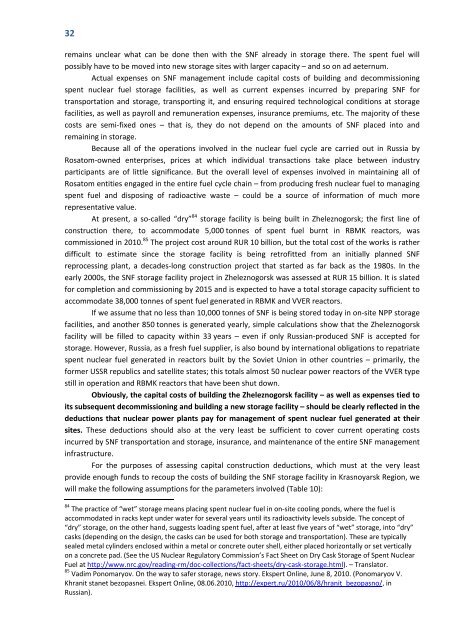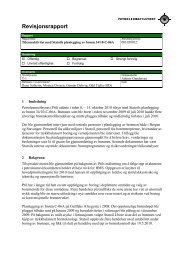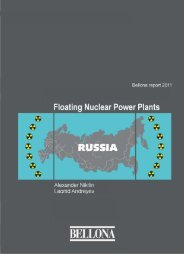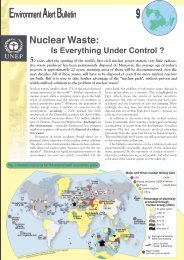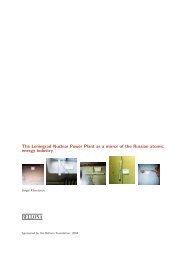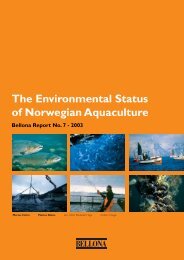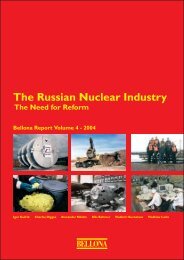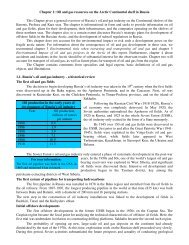The Economics of the Russian Nuclear Power Industry - Bellona
The Economics of the Russian Nuclear Power Industry - Bellona
The Economics of the Russian Nuclear Power Industry - Bellona
You also want an ePaper? Increase the reach of your titles
YUMPU automatically turns print PDFs into web optimized ePapers that Google loves.
32remains unclear what can be done <strong>the</strong>n with <strong>the</strong> SNF already in storage <strong>the</strong>re. <strong>The</strong> spent fuel willpossibly have to be moved into new storage sites with larger capacity – and so on ad aeternum.Actual expenses on SNF management include capital costs <strong>of</strong> building and decommissioningspent nuclear fuel storage facilities, as well as current expenses incurred by preparing SNF fortransportation and storage, transporting it, and ensuring required technological conditions at storagefacilities, as well as payroll and remuneration expenses, insurance premiums, etc. <strong>The</strong> majority <strong>of</strong> <strong>the</strong>secosts are semi‐fixed ones – that is, <strong>the</strong>y do not depend on <strong>the</strong> amounts <strong>of</strong> SNF placed into andremaining in storage.Because all <strong>of</strong> <strong>the</strong> operations involved in <strong>the</strong> nuclear fuel cycle are carried out in Russia byRosatom‐owned enterprises, prices at which individual transactions take place between industryparticipants are <strong>of</strong> little significance. But <strong>the</strong> overall level <strong>of</strong> expenses involved in maintaining all <strong>of</strong>Rosatom entities engaged in <strong>the</strong> entire fuel cycle chain – from producing fresh nuclear fuel to managingspent fuel and disposing <strong>of</strong> radioactive waste – could be a source <strong>of</strong> information <strong>of</strong> much morerepresentative value.At present, a so‐called “dry” 84 storage facility is being built in Zheleznogorsk; <strong>the</strong> first line <strong>of</strong>construction <strong>the</strong>re, to accommodate 5,000 tonnes <strong>of</strong> spent fuel burnt in RBMK reactors, wascommissioned in 2010. 85 <strong>The</strong> project cost around RUR 10 billion, but <strong>the</strong> total cost <strong>of</strong> <strong>the</strong> works is ra<strong>the</strong>rdifficult to estimate since <strong>the</strong> storage facility is being retr<strong>of</strong>itted from an initially planned SNFreprocessing plant, a decades‐long construction project that started as far back as <strong>the</strong> 1980s. In <strong>the</strong>early 2000s, <strong>the</strong> SNF storage facility project in Zheleznogorsk was assessed at RUR 15 billion. It is slatedfor completion and commissioning by 2015 and is expected to have a total storage capacity sufficient toaccommodate 38,000 tonnes <strong>of</strong> spent fuel generated in RBMK and VVER reactors.If we assume that no less than 10,000 tonnes <strong>of</strong> SNF is being stored today in on‐site NPP storagefacilities, and ano<strong>the</strong>r 850 tonnes is generated yearly, simple calculations show that <strong>the</strong> Zheleznogorskfacility will be filled to capacity within 33 years – even if only <strong>Russian</strong>‐produced SNF is accepted forstorage. However, Russia, as a fresh fuel supplier, is also bound by international obligations to repatriatespent nuclear fuel generated in reactors built by <strong>the</strong> Soviet Union in o<strong>the</strong>r countries – primarily, <strong>the</strong>former USSR republics and satellite states; this totals almost 50 nuclear power reactors <strong>of</strong> <strong>the</strong> VVER typestill in operation and RBMK reactors that have been shut down.Obviously, <strong>the</strong> capital costs <strong>of</strong> building <strong>the</strong> Zheleznogorsk facility – as well as expenses tied toits subsequent decommissioning and building a new storage facility – should be clearly reflected in <strong>the</strong>deductions that nuclear power plants pay for management <strong>of</strong> spent nuclear fuel generated at <strong>the</strong>irsites. <strong>The</strong>se deductions should also at <strong>the</strong> very least be sufficient to cover current operating costsincurred by SNF transportation and storage, insurance, and maintenance <strong>of</strong> <strong>the</strong> entire SNF managementinfrastructure.For <strong>the</strong> purposes <strong>of</strong> assessing capital construction deductions, which must at <strong>the</strong> very leastprovide enough funds to recoup <strong>the</strong> costs <strong>of</strong> building <strong>the</strong> SNF storage facility in Krasnoyarsk Region, wewill make <strong>the</strong> following assumptions for <strong>the</strong> parameters involved (Table 10):84 <strong>The</strong> practice <strong>of</strong> “wet” storage means placing spent nuclear fuel in on‐site cooling ponds, where <strong>the</strong> fuel isaccommodated in racks kept under water for several years until its radioactivity levels subside. <strong>The</strong> concept <strong>of</strong>“dry” storage, on <strong>the</strong> o<strong>the</strong>r hand, suggests loading spent fuel, after at least five years <strong>of</strong> “wet” storage, into “dry”casks (depending on <strong>the</strong> design, <strong>the</strong> casks can be used for both storage and transportation). <strong>The</strong>se are typicallysealed metal cylinders enclosed within a metal or concrete outer shell, ei<strong>the</strong>r placed horizontally or set verticallyon a concrete pad. (See <strong>the</strong> US <strong>Nuclear</strong> Regulatory Commission’s Fact Sheet on Dry Cask Storage <strong>of</strong> Spent <strong>Nuclear</strong>Fuel at http://www.nrc.gov/reading‐rm/doc‐collections/fact‐sheets/dry‐cask‐storage.html). – Translator.85 Vadim Ponomaryov. On <strong>the</strong> way to safer storage, news story. Ekspert Online, June 8, 2010. (Ponomaryov V.Khranit stanet bezopasnei. Ekspert Online, 08.06.2010, http://expert.ru/2010/06/8/hranit_bezopasno/, in<strong>Russian</strong>).


